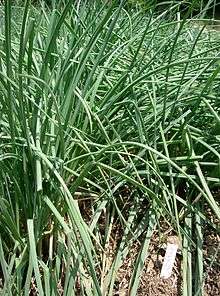Allium chinense
Allium chinense (also known as Chinese onion,[3][4] Chinese scallion,[3] glittering chive,[5] Japanese scallion,[3] Kiangsi scallion,[4] and Oriental onion[3]) is an edible species of Allium, native to China,[3] and cultivated in many other countries.[6] Its close relatives include the onion, shallot, leek, chive, and garlic.[7]
| Chinese onion | |
|---|---|
 | |
| Scientific classification | |
| Kingdom: | Plantae |
| Clade: | Tracheophytes |
| Clade: | Angiosperms |
| Clade: | Monocots |
| Order: | Asparagales |
| Family: | Amaryllidaceae |
| Subfamily: | Allioideae |
| Genus: | Allium |
| Species: | A. chinense |
| Binomial name | |
| Allium chinense | |
| Synonyms[2] | |
Distribution
Allium chinense is native to China (in Anhui, Fujian, Guangdong, Guangxi, Guizhou, Hainan, Henan, Hubei, Hunan, Jiangxi, and Zhejiang provinces).[3] It is naturalized in other parts of Asia as well as in North America.[3][8][9]
Uses
Culinary
Owing to its very mild and "fresh" taste A. chinense is often pickled and served as a side dish in Japan and Vietnam, to balance the stronger flavor of some other component in a meal. For example, in Japanese cuisine it is eaten with Japanese curry as a garnish.[10]
In Vietnam, pickled A. chinense, known as Củ kiệu Huế, is often served during Tết (Vietnamese New Year).
In Japanese, it's known as Rakkyō (辣韮 or 薤). Glass bottles of white Rakkyō bulb pickles are sold in Asian supermarkets in North America.
Medicinal
Allium chinense is used as a folk medicine in tonics to help the intestines, and as a stomachic.[11]
See also
- Allium tuberosum, also known as garlic chives – A species of onion native to southwestern parts of the Chinese province of Shanxi
- Pickled onion – Onions pickled in a solution of vinegar or salt
References
- Brummitt, N. (2013). Allium chinense. The IUCN Red List of Threatened Species 2013: e.T44392537A44396666. doi:10.2305/IUCN.UK.2013-2.RLTS.T44392537A44396666.en Downloaded on 05 January 2019.
- "Allium chinense". World Checklist of Selected Plant Families. Royal Botanic Gardens, Kew. Retrieved 2013-05-28.
- "Allium chinense". Germplasm Resources Information Network (GRIN). Agricultural Research Service (ARS), United States Department of Agriculture (USDA). Retrieved 2017-12-15.
- Multilingual Multiscript Plant Name Database: Allium. University of Melbourne. Updated 3 August 2013. Retrieved 5 September 2014.
- English Names for Korean Native Plants (PDF). Pocheon: Korea National Arboretum. 2015. p. 347. ISBN 978-89-97450-98-5. Archived from the original (PDF) on 25 May 2017. Retrieved 17 December 2016 – via Korea Forest Service.
- Flora of China Vol. 24 Page 196 藠头 jiao tou Allium chinense G. Don, Mem. Wern. Nat. Hist. Soc. 6: 83. 1827.
- Block, E. (2010). Garlic and Other Alliums: The Lore and the Science. Royal Society of Chemistry. ISBN 0-85404-190-7.
- Plants For A Future: Allium chinense
- United States Department of Agriculture Plants Profile: Allium chinense
- http://justhungry.com/japanese-beef-curry
- James A. Duke. "Allium chinense (LILIACEAE)". Dr. Duke's Phytochemical and Ethnobotanical Databases. Retrieved 2017-12-15.
External links
![]()

.jpg)